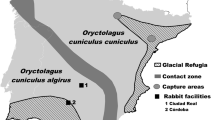Summary
An accurate age-estimating technique, based on biochemical changes in eye lens protein, was used to study age structures of six populations of the old-field mouse,Peromyscus polionotus. A new mathematical procedure permitted quantitative comparisons of these populations. Four inland populations had essentially the same median ages (75–84 days), maximum ages (248–297 days) and relative production rates (56–58% of the surviving population had been born in the 100 days prior to sampling). Approximately 50% of the females were old enough to have weaned a litter. One inland population had a lower median age (49 days), a lower maximum age (181 days) and a higher relative production rate (73%). Relatively fewer females (38%) could have weaned a litter. The single beach population was also different, with higher median age (180 days), and lower relative production rate (2%). All females were old enough to have weaned a litter. Maximum age was essentially the same as for the four similar, inland populations. Factors which may have contributed to observed differences in these populations are discussed.
Similar content being viewed by others
Literature Cited
Dapson, R. W., J. G. Otero andW. R. Holloway (1968) Biochemical changes with age in the lenses of white mice.Nature 218: 573.
Dapson, R. W. (1971) Quantitative comparison of populations with different age structures.Annales Zoologici Fennici 8: 75–79.
Dapson, R. W. andJ. M. Irland (In press) An accurate method of determining age in small mammals.Jour. Mamm. 53.
Eisenhart, C. (1939) The interpretation of certain regression methods and their use in biological and industrial research.Ann. Math. Stat. 10: 162–186.
Golley, F. B., E. L. Morgan andJ. L. Carmon (1966) Progression of molt inPeromyscus polionotus.Jour. Mamm. 47: 145–148.
Layne, J. N. (1968) Ontogeny,In J. A. King (ed.),Biology of Peromyscus (Rodentia). Spec. Publ. No. 2, Amer. Soc. Mamm.
McCarthy, P. J. (1957)Introduction to statistical reasoning. McGraw-Hill, New York.
Simpson, G. G., A. Roe andR. C. Lewontin (1960)Quantitative zoology. Harcourt, Brace and World, New York.
Smith, M. H. (1968) A comparison of different methods of capturing and estimating numbers of mice.Jour. Mamm. 49: 455–462.
Steel, R. G. D. andJ. H. Torrie (1960)Principles and procedures of statistics. McGraw-Hill, New York.
Terman, C. R. (1968) Population dynamics.In J. A. King (ed.),Biology of Peromyscus (Rodentia). Spec. Publ. No.2, Amer. Soc. Mamm.
Author information
Authors and Affiliations
Rights and permissions
About this article
Cite this article
Dapson, R.W. Age structure of six populations of old-field mice,Peromyscus polionotus . Res Popul Ecol 13, 161–169 (1972). https://doi.org/10.1007/BF02521975
Issue Date:
DOI: https://doi.org/10.1007/BF02521975



